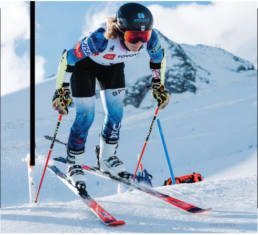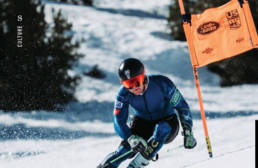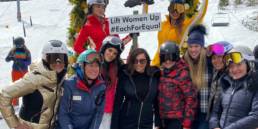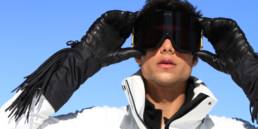
America’s Cup yacht racing and polo are the only two ports that leap immediately to mind as being more expensive than ski racing. Big boats and fast horses are spendy. But for skiers and boarders, it has as much to do with coaching, tuners, training, travel, and injuries as it does with gear. And the gear ain’t cheap.
It’s a rare competitor who can afford to self-fund all the way up to the World Cup level. They can learn to deal with the rigors of year-round training, the endless days and years on the road, and the constant specter of career-ending injuries. But stressing over how they and their families are going to foot the bill for their dreams is a very big load.
And it starts at a young age in ski clubs, where the costs can quickly turn eye-watering for anyone who shows talent and would be well-served by additional coaching and camps.
better equipment, travel to bigger competitions, and a comprehensive insurance policy to cover it all. By the time a racer reaches the elite level, it makes the price of an Ivy League college look reasonable.
“We’ve figured it costs about $188,000 per year for an alpine racer on the World Cup,” says Megan Harrod, communications manager for the US Ski Team. “All of our named A-C Team athletes are fully travel funded so do not have to cover this $188,000 cost. Development Team athlete costs have also been reduced significantly so it is now a flat fee of $10,000 per athlete, and we are also working to defray these costs further with new grants.”
Those grant sources include the World Cup Dreams Foundation, founded by Americangiantslalom ace Erik Schlopy and downhiller Bryon Friedman in 2010.

has raised over $1 million and worked with the T2 Foundation to help support “ski racers who require additional funding not fully provided by the national federation.”
Recently WCDF and T2 merged as World Cup Dreams and former American ski racer Tommy (Beezy) Biesemeyer took over as Executive Director. “There was a season, 2015-2016, where 1 needed financial help to pay medical and team fees and WCDF stepped up and provided the support I needed to keep my dream alive,” he says. “I knew I always wanted to give back to the mission that once helped me. Taking over as Executive Director was a role that happened quickly. After being approached by the board I was running the foundation three weeks later.”
World Cup Dreams approaches its mission on several fronts. One is to provide $250,000 worth of annual individual scholarships “to athletes at club level all the way to the national team athletes,” says Biesemeyer, as well as supporting the Stratton Mountain School team in Vermont and Bridger Bowl cross-country teams in Montana. In that process, they enlist their sponsored athletes to help fundraise “by leveraging their own networks,” and deal one-on-one with donors to WCDF.
US Alpine A-Team member Alice Merryweather, who finished 15th in the 2018 Olympic Alpine Combined, and 8th in the 2018 Garmisch World Cup downhill, is one of WCD’s most prominent and senior athletes. “Even though the US Ski Team pays for all my race and training camp travel, coaching, and lodging fees, expenses at the World Cup level can still be quite high,” she says. “For instance, 1 choose to live in Park City for the summer to access our training headquarters, and I have to
cover all those living expenses on my own. That’s where World Cup Dreams steps in. They help me with rent, food, gas, and training equipment costs so that 1 can focus on my workouts with less stress.”
She also notes that “As awkward and uncomfortable as it can be to ask for money, I think that the athletes should absolutely be involved in their own fundraising. Those conversations can open up a whole network of connections to help athletes during their ski careers and beyond. 1 also think it’s vital to show gratitude and respect for the people helping me out.”
Biesemeyer stresses that their foundation is “moneydriven” but that “there is more to this sport than just throwing money at a tan athlete and thinking that it will solve all the issues. We have recently partnered with GiveGo, a virtual online coaching platform, to integrate vertical mentorship within our team. This means that we will have our younger athletes submitting videos and then be coached by our senior team athletes.”
These relationships also help establish a dialogue on a more personal level so that when other issues arise – injuries, hardships, mental struggles – the younger athletes have someone to talk to. “I know I wish I had something like this when I was competing,” says Biesemeyer.
WCD-sponsored US Team member Nina O’Brien loves the idea. The eight-time US National champion who placed 10th in the World Championship GS at Cortina last season has been supported by the T2 Foundation since 2016 and says, “I truly could not have made it to the World Cup without them.”
adds about the mentoring program, “I think there’s so much that we can all learn from each other, whether that’s ski technique, advice on how to approach a specific race hill or mental training. The cool thing about mentorship is that I truly believe it can work both ways. Everyone has a unique perspective and even the most experienced mentors can learn from their mentees.”
Erik Arvidsson, a fast-rising USA Team member who placed 8th at a World Cup downhill in Saalbach last season, is also enthused. “WCDF’s partnership with GiveGo has allowed me to connect with and mentor up-and-coming athletes no matter where I am racing or training in the world. I am excited to continue to grow those relationships.”
Another major aspect of the costs of ski racing is injuries. “During my 12-year career with the US Ski Team, injuries became an annual experience resulting in 13
operations,” Biesemeyer says in his Bio. “What is often overlooked is the financial burden associated with season-ending injuries. WCDF is going to alleviate those hurdles so athletes like myself can keep their dreams alive.”
“Tommy hit the nail on the head here,” says Arvidsson. “While the US Ski Team and the USOPC [United States Olympic and Paralympic Committee] do an incredible job of providing medical care as well as rehab and training resources for inured athletes, when athletes lose their primary income sources (prize money and victory schedule bonuses from sponsors) due to injury it can be really hard to make ends meet. Thus, supporting injured athletes is an incredible way for WCDF to have an immediate impact on our sport.”
O’Brien lists “medical expenses” as one of her budget necessities, and Merryweather is another current and unfortunate example. After taking last year off to deal with an eating disorder, 2021-2022 was to be a comeback season for her. Then in early September, she crashed at nearly 80mph on a training run on the glaciers of Saas-Fee, Switzerland, sustaining facial lacerations, two broken bones in one leg, and a damaged knee.
Happening during an Olympic season, it’s an especially brutal setback. But she posted “huge” thanks to “my coaches, doctors, physios, helicopter pilots, teammates, friends and family” on Instagram, and said that while the recovery looks daunting, “If I can rewire my brain [to battle anorexia) I think I can heal some bones and ligaments too.”
Arvidsson also points out the advantages of the WCD injury assistance even to racers who haven’t yet been hurt. While he’s been lucky so far to avoid any season-ending injuries in his career, “I’m thankful that through WCDF, I know I am going to be fine
no matter what happens on the hill.” In addition, Arvidsson appreciates the benefits of WCD sponsorships in significantly opening up opportunities in ski racing. “I am excited to see how WCDF under Beezywill is able to make our sport more accessible to all kids who want to be the next LindseyVonn or Bode Miller,” he says.
Across the range of all sports – from soccer and baseball to golf, tennis, rodeo, and even yacht racing and polo – inclusivity benefits all of us. And sports, in general, help people the most when everyone wins. Not everyone can get gold medals and big paydays for pursuing their dreams, but they can all gain confidence and pride going forward in their lives, bolstered by the knowledge that others cared enough to give them the chance.





